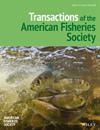Comparing standard‐ and reduced‐size passive integrated transponder (PIT) tags for monitoring juvenile wild spring Chinook Salmon
IF 2
3区 农林科学
Q2 FISHERIES
引用次数: 0
Abstract
ObjectivesAnnual migration monitoring can help to discern patterns and environmental factors that impact growth, survival, and movement timing in small fish. Mark–recapture methods form the basis for such monitoring, and the standard 12‐mm passive integrated transponder (PIT) tag has emerged as an essential tool for studies of juvenile salmonids. A smaller, 9‐mm PIT tag now provides the potential to conduct mark–recapture studies on smaller fish. We evaluated relative performance of the 9‐mm tag, which is similar in design to its 12‐mm predecessor.MethodsFor this comparison, we tagged and released approximately 8400 wild spring Chinook Salmon比较用于监测野生春季大鳞大麻哈鱼幼鱼的标准型和缩小型被动集成应答器(PIT)标签
目标一年一度的洄游监测有助于发现影响小型鱼类生长、存活和移动时间的模式和环境因素。标记再捕获方法是此类监测的基础,标准的 12 毫米被动集成应答器 (PIT) 标签已成为研究幼年鲑鱼的重要工具。现在,一种更小的 9 毫米 PIT 标签为对更小的鱼类进行标记重捕研究提供了可能。我们评估了 9 毫米标签的相对性能,该标签的设计与其前身 12 毫米标签类似。为了进行比较,我们在 2011 年至 2013 年期间在爱达荷州谷溪标记并释放了约 8400 尾野生春季大鳞大麻哈鱼(Oncorhynchus tshawytscha)幼鱼。标记大小的群组平均体型相似,标记数量相同。我们估算了两个河段中每个群组的存活率和检测概率。结果在这两个河段中,不同年份的存活率各不相同,但我们观察到不同标签大小的群组之间没有显著差异。在谷溪,带有 9 毫米标签的鱼的平均检测率略低于带有 12 毫米标签的鱼的二分之一,而且在所有三年中都明显较低。在下花岗岩大坝,9 毫米标签的检出率也较低,但差异要小得多(3%-12%),而且没有统计学意义。然而,9 毫米标签的检测率较低,可能导致估算结果不够精确,因此在使用这些标签进行研究时,应考虑特定地点的检测率。
本文章由计算机程序翻译,如有差异,请以英文原文为准。
求助全文
约1分钟内获得全文
求助全文
来源期刊
CiteScore
2.90
自引率
7.10%
发文量
48
审稿时长
8-16 weeks
期刊介绍:
Transactions of the American Fisheries Society is a highly regarded international journal of fisheries science that has been published continuously since 1872. It features results of basic and applied research in genetics, physiology, biology, ecology, population dynamics, economics, health, culture, and other topics germane to marine and freshwater finfish and shellfish and their respective fisheries and environments.

 求助内容:
求助内容: 应助结果提醒方式:
应助结果提醒方式:


